|
Introduction
During August and
September of 2006, I worked in La Parguera, Puerto Rico assisting
with coral spawning research as part of an internship program
through the University of North Carolina, Wilmington (UNCW)
and the University of Puerto Rico, Mayaguez (UPRM). The goals
of this research project were to increase the knowledge of
collecting coral gametes, of rearing and settling coral larvae,
and to perform several experiments on the environmental tolerance
limits of coral larvae and ecological interactions of corals
with their environment. The spawn was collected from colonies
of the glorious, but threatened, Elkhorn coral, star corals
and several others. The spawn was collected in the field and
from captive colonies of species that were collected for the
spawning event and later replaced on the reef. Although our
efforts were headquartered at the UPRM marine station on Isla
Magueyes, our field work was carried out at many reef sites
around Puerto Rico.
We were fortunate that a group from Project SECORE was conducting
a workshop on sexual coral reproduction at the same location
where we conducted our research. SECORE (SExual COral REproduction)
Project is an international initiative of public aquariums
and coral research institutions dedicated to conservation
through the sustainable management of coral reefs. The SECORE
group and my group had very similar goals, and throughout
the 10-day spawning blitz we helped each other in various
ways. This was a thoroughly enriching experience for me, not
only for all that I learned about working with sexual coral
reproduction, but also for the repetitive reef diving, which
gave me an intimate view of almost all of the Caribbean's
stony coral species.
The Corals
Before the corals
spawned, many preparations had to be made. All the activities
leading up to the big event focused on keeping the coral larvae
alive and rearing them to the proper developmental stages.
Our research efforts focused on several species: Acropora
palmata (Elkhorn coral), Montastrea faveolata (Mountainous
Star coral), Montastrea cavernosa (Great Star coral),
Diploria strigosa (Brain coral), and Favia fragum
(Golfball coral). All but the last of these species are important
reef builders. Because corals grow attached to the reef bottom,
the only times in their lives when they move around is when
they begin life as drifting gametes and then, later in their
life, when they are swimming larvae called planulae. Planula
larvae are very sensitive to small variations in environmental
conditions. The effects of elevated temperature can have strong
consequences for the survival of coral larvae (Bassim and
Sammarco, 2003) and sedimentation can have large consequences
for the settlement success and long term survival of juvenile
corals (Hodgson, 1990, Babcock and Davies, 1991). The coral
spawning research conducted in Puerto Rico was aimed principally
at increasing our understanding of the characteristics of
corals' early life history in order to learn more about these
important reef-building stony corals.
 |
|
Figure 1: Elkhorn coral is a major builder of
Caribbean coral reefs. It grows to become the largest
and most recognizable coral in the world, sometimes
attaining the size of a small tree. Unfortunately, the
abundance of Elkhorn coral has decreased dramatically
in recent years. This summer it became the first coral
to be listed as a threatened species under the Endangered
Species Act.
|
Acropora palmata is commonly known as Elkhorn coral
because its colonies are composed of thick, broad branches,
and colonies grow to produce some of the largest colonies
of all corals. Elkhorn coral is critical in building reefs
because it can grow very fast, and because it produces a sturdy
reef structure. Although entire reef zones formerly consisted
almost entirely of this species, in recent years this species
has declined by 90-99% of its former population abundance
throughout most of its range. The decline has been alarming
enough to warrant listing this coral as a threatened species
protected by the Endangered Species Act. Acropora palmata
occurs almost exclusively in very shallow, very high energy
environments. Even with an aquarium system designed specifically
for A. palmata, the track record for this species'
captive survival is very poor, although few proper efforts
have been made. The decline of this important Caribbean reef
building species underscores the importance of learning how
to propagate the species both sexually and asexually.
 |
|
Figure 2: Mountainous Star coral grows into massive
mounds which can be much larger than the colony in this
picture.
|
As Elkhorn coral's abundance has declined, one of the coral
species that has become increasingly important for reef building
is Montastraea faveolata, the Mountainous Star coral.
Montastraea faveolata, M. annularis and M.
franksi are sibling species which predominantly grow into
massive forms, and they occur in a wide range of habitats.
Although these species grow more quickly than many others,
their growth rate is much slower than Elkhorn coral. Unfortunately,
although we had intended to do a lot of work with this species,
very high temperatures from the previous year caused many
colonies to undergo reproductive failure. During the winter
of 2005, an abnormally large heat content existed around Puerto
Rico and the Virgin Islands. The higher than normal water
temperatures lasted many months, and it caused a great deal
of bleaching in this species. The bleaching event overlapped
with the beginning of its gamete maturation period. Even months
after the bleaching, many of the really large, mature colonies
of M. faveolata showed yellow blotching which may have
been due to impartial bleaching recovery or the onset of disease.
In the end, we witnessed only a scant dribble of egg/sperm
bundle release in this species, so we pretty much scrapped
our plans to use it for our experiments.
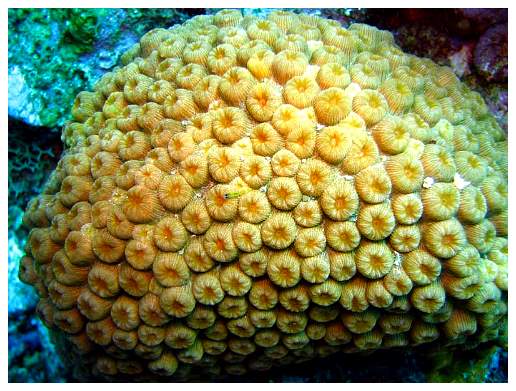 |
|
Figure 3: It was recently discovered that orange
specimens of Montastrea cavernosa, such as this
one, get their fluorescence from the presence of nitrogen-fixing
bacteria (Lesser et al, 2004).
|
Montastraea cavernosa is one of my favorite corals
in the Caribbean. It is an important reef building coral which
can grow to over 2m across. Its growth forms can be massive
and encrusting, occasionally plating or pillar-like, but it
is most often sub-massive. I have long known that this coral
occurred in an attractive red/orange morph, but the range
of colors that I observed in Puerto Rico alone was highly
diverse. The orange fluorescence of some specimens is known
to be caused by the presence of symbiotic nitrogen-fixing
cyanobacteria (Lesser et al, 2004). Within this species,
there appears to be two growth forms, which some taxonomists
suspect may be different species. The two forms may also be
reproductively isolated because they may broadcast their gametes
a few days apart. The issue is muddled by the existence of
intermediate colonies that display characteristics of both
forms in different parts of the same colony.
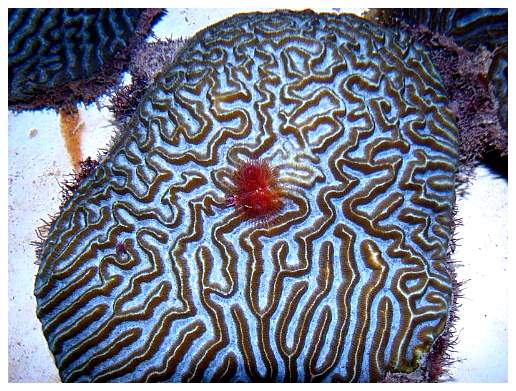 |
|
Figure 4: Some specimens of Diploria strigosa
contain striking blue colors.
|
The Atlantic Brain coral Diploria strigosa is a very
common and easily recognized species on Caribbean reefs. It
is characterized by a massive growth form and usually strongly
meandroid corallite valleys. This species' colonies often
grow into large spherical mounds, and it frequently hosts
many commensal Christmas tree worms (Spirobranchus giganteus).
Diploria strigosa is the most abundant of the three
species in the genus Diploria. The genus' other species
include the sharper grooved D. clivosa, which is generally
found in water less than 7m, and the usually larger grooved
D. labyrynthiformis, which occurs in the same depth
range as D. strigosa but which persists at depth where
D. strigosa does not occur (personal observation).
The final species used for our research was the Golf Ball
coral, Favia fragum. This species is different from
those previously discussed in that it attains a maximum size
of only several inches in diameter. It often grows in a spherical
shape, hence its name, and it also differs in that it is a
brooding coral instead of a broadcast spawner. This species
is common and widespread occurring in a range of environments
from calm reef zones such as back reefs, mangroves and seagrass
beds, but it can also occur in the sheltered microhabitats
of high energy reefs. This species is not a critical reef
building species, but it still serves as a model species for
studying brooding corals because it is very abundant, it matures
at a relatively small size and it releases larvae every month.
Before the Spawn
Even before the main team arrived
in Puerto Rico, many preparations had been made in North Carolina
and in La Parguera. While we were in Wilmington, the other
interns and I worked to build spawn collectors, larval housing
chambers and larval settling chambers. The materials we used
to construct these items were all some form of nylon cloth
which we connected by sewing. Although it was the last thing
I expected to learn from a coral spawning internship, using
a sewing machine was the first thing I learned to do on this
job. Meanwhile, in La Parguera about 100 limestone blocks
in two shapes were placed at different sites on a couple of
reefs to obtain the necessary biotic film that encourages
coral larvae to settle (Heyward and Negri, 1999). One of the
types of blocks was conditioned with varying degrees of shading
and grazing in order to produce small communities of encrusting
organisms. Because coral larvae can sense biological cues
to settlement (Morse et al, 1996), the experimentally
conditioned blocks were used to see the community effects
on coral settlement and survivorship.
Once we arrived in La Parguera, we made our facilities conducive
to raising coral larvae and to performing our research experiments.
One of our first tasks was to organize our seawater culture
area and to re-engineer most of the plumbing. We serviced
the rapid sand filter and the micron filter, which processed
all the feed water from the seawater reservoir. We also reworked
most of the plumbing to deliver one circuit of really slow,
high pressure water to the dozen or so coral larvae chambers
and another circuit of really high water flow for water tables
we used to house spawning branches of A. palmata, and colonies
of M. cavernosa and D. strigosa. Because water movement is
one of
my areas of interest and expertise, my project was to
configure the maximum water flow tank which was used to house
the A. palmata branches. One issue with increasing
the water circulation in our water tables was that the incoming
water was arriving at 31°C / 87°F, so it was important
that the water flow mechanisms I added would not increase
the water's temperature. In the end, I opted for a three-pronged
approach to moving water in this tank. I added a Penductor
to the line feeding incoming water to the tank. Two Vortech
pumps on opposite sides of the water table were switched on
alternately using a Chauvet light timer. The final effort
was a tall 30-gallon polycarbonate cylinder, which was converted
for use as a self-starting siphon surge device. The combination
of all these water flow devices resulted in strong mass water
movement, producing flow speeds in excess of 30cm/s in many
parts of the tank. Some of the branches we collected for this
tank succumbed to tissue loss within a couple of days, perhaps
due to the high water temperature. After this initial setback,
most of the branches seemed to tolerate this high flow tank
well; they all showed great polyp extension, and we suffered
no subsequent losses.
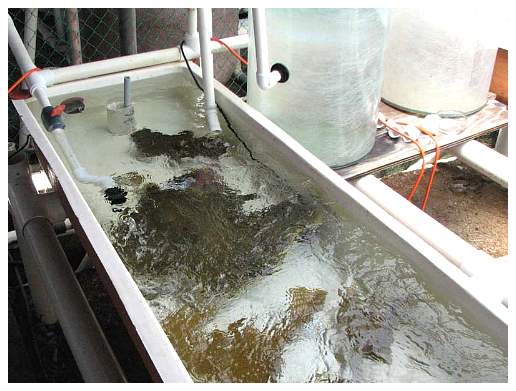 |
|
Figure 5: This image shows the Penductor, Vortech
pump and surge device that provided mass water movement
for this tank, which was dedicated to temporarily housing
spawning branches of Acropora palmata.
|
The Sites
The coral gametes were collected from
wild and captive-held coral colonies at several locations
around La Parguera and Rincón, Puerto Rico. Isla Magueyes
is at the center of the Parguera reefs (satellite
view). This is where we built our coral rearing systems,
and it is where we coordinated the boating excursions and
diving activities. For captive-held corals, we collected about
eight large branches of A. palmata and 12 colonies
each of D. strigosa and M. faveolata. All the
colonies were collected from the forereef of Margarita reef
and Media Luna reef, which are about halfway to the shelf's
edge or approximately three miles from shore. Small colonies
of F. fragum were collected from the calm backreef
of St. Cristobal Reef and near the shore on Isla Magueyes.
To collect coral gametes from the field, it is necessary
to plan the collection of coral spawn where there is an abundance
of the target species, because usually not all colonies of
the same coral species spawn on a given night. Fortunately,
Puerto Rico has a couple of sites where A. palmata
are still the dominant species with 100s-1000s of colonies
present. The northern coastline of Puerto Rico is exposed
to strong currents and waves. All this water movement whips
around the island's northwestern tip, which provides great
circulation and favorable growing conditions for Elkhorn coral
at Rincón and Baja Gallardo where some healthy stands
still exist. My research group went only to Rincón,
but the SECORE group divided its members and collected from
both sites. The reefs at Rincón were adjacent to the
shore so it was practical for us to do our diving and spawn
fertilization work from there. Montastrea faveolata
is much more abundant than A. palmata overall, so for
this species we were able to deploy from Isla Magueyes to
another reef in Parguera called Turramote reef, but since
the colonies that didn't die from the previous year's bleaching
event still failed to produce any significant quantity of
gametes, it was really disheartening to go to this reef on
successive nights only to see such giant colonies release
egg/sperm bundles only from tiny patches of the colony.
The Spawning
Coral spawning behaviors can be classified
based upon whether spawn is broadcast into the water column
or whether it is brooded internally. Broadcast spawning corals
release eggs and sperm into the water column, and they tend
to have an annual reproductive cycle. If a broadcast spawning
coral is hermaphroditic, it packages egg and sperm into buoyant
bundles; otherwise, eggs and sperm are released separately.
Egg and sperm float to the surface where they mix, fertilize
and are carried away by water currents. Brooding corals either
release sperm into the water column or self-fertilize, in
which case no sperm is released. The internally fertilized
egg is brooded within the parent coral's tissue until it becomes
a larvae, at which point it exits the parent's polyp, usually
from the mouth or through a tentacle's tip. Although broadcast
spawners release a massive quantity of tiny eggs one or two
nights per year, some brooders produce an order of magnitude
fewer larvae which are released periodically, all month long
or for a few nights each month throughout most months of the
year. The planulae and resulting primary polyps of brooding
corals are usually much larger than those of broadcasting
corals. Of all the corals we worked with, F. fragum
was the only brooding coral.
The successful collection of broadcasting coral spawn depends
on overcoming two obstacles: the timing of the spawning event
must be correctly estimated, and the gametes must be physically
collected. It is important to note that corals' reproductive
effort begins well before it culminates with mass spawning
events during later summer months. The species we worked with
begin producing gametes as early as November - the month when
stony coral spawns appear to be influenced by a combination
of water temperature (Mendes et al, 2002) and exposure
to sunlight (Penland et al, 2004). For our coral species
of interest, the spawning can occur over one to four days,
and this typically can occur anywhere between seven to 15
days after the full moon. The spawning occurs after sunset
and the precise timing of release depends on the species and
the location. At Rincón, the Elkhorn began releasing
gametes after 9pm, but the brain corals did not begin releasing
them until nearly midnight. In some places the time of spawning
is so predictable that you can set your watch by it, although
this is not usually the case. The entire spawning effort is
a very concerted event which ends abruptly. Although the cues
we used were reliable to predict gamete release for the corals
in our research area, the timing of coral spawning is a very
dynamic mechanism, mediated by a variety of factors which
we are only beginning to understand.
Collecting the gametes of broadcasting corals varied depending
on the type of coral. For species with separate sexes such
as Montastrea cavernosa, it is not practical to collect
sperm in the field so mature colonies were spawned in captive
aquaria. In Puerto Rico, Diplora strigosa spawns very
late so this species was also spawned in aquaria. Once these
two species had spawned, we collected the fertilized eggs
that accumulated at the surface. Spawning corals in captivity
is fine for producing a modest quantity of larvae, but in
order to obtain massive amounts of coral gametes, we had to
collect gametes in the field using spawning nets or spawn
catchers. The spawn catchers are simply large cones with a
buoyant cup at the tip and a thin sleeve at the perimeter
which encloses semi-rigid tubing to hold the fabric into shape.
Because coral egg bundles are buoyant, the spawn catcher's
conical shape collects floating egg bundles from a large area
or whole colony and guides them into the floating collecting
cup at the tip. When it appeared that no more eggs were being
collected into the cup, we quickly capped it off and brought
the sample to shore where it could be mixed with other spawn.
The collection of coral gametes is not as straightforward
as it sounds. When we used spawn catching nets in the surge
of Rincón's Elkhorn reefs, our spawning efforts yielded
only about 100,000 eggs. Meanwhile, the SECORE crew plankton
mesh hand collectors to collect gobs of spawn that accumulated
at the surface. Although our current number of eggs could
have yielded enough larvae for our experiments, after final
attrition by fertilization success and survival rate, we had
a very small margin of error to meet our desired quotas. Very
generous donations of gametes and larvae from SECORE afforded
our research a much more comfortable abundance of larvae.
I want to take this opportunity to thank SECORE for their
contributions to our research experiments.
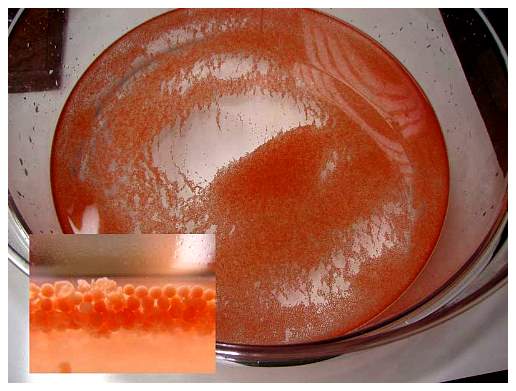 |
|
Figure 6: This bin's volume is about 3 gallons
(10 liters), and it contains several tens of thousands
of developing Acropora palmata eggs. The inset
shows round and uniform eggs that are healthy; everything
else is the result of spawn material which is breaking
down.
|
After the Spawn
Once the spawn has been collected,
the stress of collecting subsides and is replaced by the pressure
of using the spawn to produce coral. Many different
stages occur between the time an egg is fertilized until the
larvae becomes primary polyp. Depending on the species, the
gametes' development occurs at different rates, and it is
imperative to know the timing and requirements of each stage
in order to successfully produce corals from coral spawn.
Fertilization occurs within the first couple of hours after
spawning, and is one of the most critical steps in the entire
culturing process. Not only does fertilization ensure that
there are actually zygotes for development into coral larvae,
but it also determines the amount of maintenance that will
be performed later. Immediately following spawn collection,
the egg bundles must be allowed to break up so that the egg
and sperm can mix and become fertilized. Some species' gametes
do not self-fertilize, so it is desirable to have egg and
sperm from many different colonies in order to maximize fertilization
success. Throughout the fertilization period, the proportion
of spawn is manipulated to achieve an ideal ratio of egg and
sperm. If there is too little sperm, then not all of the eggs
will be fertilized; if there is too much sperm, then some
eggs will be fertilized multiple times (polyploid), and they
will die (although some species of Acropora are normally
polyploid). If unfertilized or polyploid, it will not develop,
and the gametes' rich nutrients will break down and can foul
the culture water. After about two hours, the eggs are rinsed
repeatedly to remove all of the sperm, as well as any debris
in the culture water. Once the post-fertilization rinse is
finished, we held the eggs overnight in unstirred, shallow
containers so that they could undergo their first few cleavages.
The following morning, those eggs that did not develop properly
start breaking down, negatively affecting the culture water
quality. After several more rinses the developing eggs were
transferred to shallow trays containing a very slow influx
of fresh seawater. The drain was filtered by a Nytek screen
with a very large surface area and a very small mesh size.
At this point the eggs are still very buoyant. They tend to
accumulate both at the surface and on the sides of the container,
so gentle water movement and occasional manual agitation is
required to keep the eggs evenly dispersed. As the fertilized
eggs develop, they lose buoyancy by metabolizing lipids, and
they also develop cilia and begin swimming. When the larvae
disperse a little more evenly throughout the water column,
they begin to stick to the filter screen so the filter must
be frequently rinsed and backflushed. The duration of this
developmental period depends mostly on the species. The typical
fertilized A. palmata egg takes about five to seven
days to develop to the larval stage, but some Diploria
species exhibit break-neck developmental speed. Diploria
can develop to fully swimming larvae in 18 hours although
larval development ultimately depends on the species, the
location and the conditions. In order to be prepared for the
next culturing stage, the batches of coral embryos must continually
be sampled and analyzed for developmental progress.
Even within a batch of coral eggs, not all of the eggs develop
into planulae at the same rate, and not all planulae are ready
to settle at the same time. Once the majority of the eggs
had developed into planula larvae, they were mostly ready
for use in our various experiments. Some batches of larvae
had to be inhibited from settling in their containers so that
they could be used in settling experiments. Planula settlement
may be encouraged by the presence of biofilm as a chemical
indicator that a substrate is suitable for settling (Heyward
and Negri, 1999). Therefore, in order to discourage premature
settlement, we frequently removed all of the larvae from a
given container in order to wipe down and remove the biofilm
from their culture vessel. Even with these precautions we
still had settlement on everything from the container to the
PVC to the screen itself. (Editor's note: The
microenvironment and the searching behavior of larvae settling
probably does depend on numerous cues, but settlement may
not require biofilms. There are things you can do to inhibit
settlement and things to enhance it, but the requirement of
cues is very uncertain at this point.)
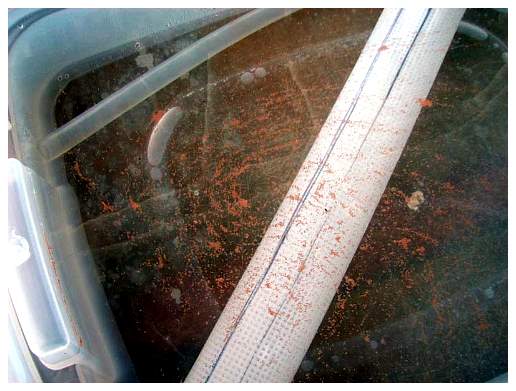 |
|
Figure 7: This is one of a dozen or so trays
used to culture coral larvae. You can see that the developing
eggs tended to gather into clumps at the surface and
on the sides.
|
Researchers still have only a very modest knowledge of the
captive care of most coral larvae. Planula larvae are tiny
creatures, and they interact with other tiny creatures, sometimes
not for the best. Toward the end of our culturing effort,
a ciliated coral predator invaded our system, and it took
a toll on some of our coral recruits. This time-lapse
video shows a small plague of ciliates almost completely
consuming a large primary polyp of F. fragum within
the span of about an hour. We had intended to use the Favia
recruits for Diadema grazing experiments, but with
the emergence of this unforeseen factor, we decided instead
to document and learn what we could from this still unidentified
protozoan. Ironically, these ciliated predators superficially
resembled planulae in size, color and movement. Because the
ciliates consumed coral tissue and green fluorescent proteins,
the new pest was particularly easy to see using fluorescence
enhancing equipment.
Conclusion
Working with corals in the wild and
in captivity is still not an exact science. Unforeseen events
can occur, and in order to learn from the experience regardless
of the outcome, the expectations of the scientist and aquarist
must be flexible enough to roll with the punches. This season,
I was rewarded with two such learning events; once during
our collection of gametes and the other during the culture
of larvae. For the last two decades aquarists have been the
pioneers of coral culture. Currently, the professional aquarists
that participate in SECORE are at the forefront of this new
aspect of coral culture. I hope that in time our knowledge
of coral spawning will increase so that further breakthroughs
in coral culture will afford home aquarists the opportunity
to work increasingly with sexual coral reproduction. Aquarists
frequently report the recruitment of coral spat from larvae
released by Pocillopora, Tubastrea and some
Euphyllia species. Many of the highly coveted, large-polyped
species of Scolymia, Cynarina, Dendrophylia
and Balanophylia are brooding corals which command
high prices because they are only currently available by the
collection of scarce, wild specimens. The rearing of larvae
released by brooding corals is relatively easy, and although
fragmentation has allowed for aquarists to asexually reproduce
many coral species, many other corals are still harvested
from the wild in great quantities because there are no known
methods of reproducing them in captivity. Because of the decline
in the abundance of some of these species, the European Union
occasionally suspends their importation. I hope that, in time,
aquarists become increasingly willing to put in the effort
to advance the techniques for reproducing corals in captivity
so that we can alleviate harvesting pressure on wild-collected
colonies, and so the hobby can continue to increase our understanding
of coral biology as a whole.
|

